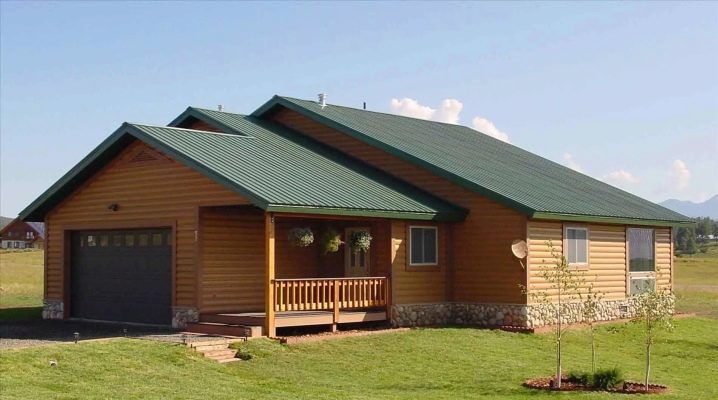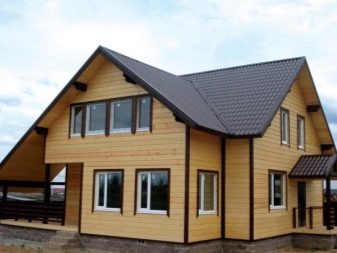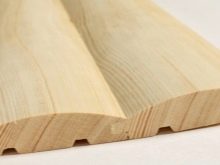Wooden siding: features of choice

Among the huge variety of outdoor finishing options, wood siding is especially popular. It is a practical, stylish and durable material that attracts the attention of others. This product has a number of features and advantages that have played an important role in the distribution of finishes.
The wood used in the production process creates a comfortable microclimate. Moreover, it is a natural and environmentally friendly material.


Finishing characteristics
Siding is a separate type of cladding material. It is mounted on the wall using a special frame, which is pre-installed on the building. This finish is very popular in Canada and throughout North America. A variety of materials can be used to make it.



Wood panels are ideal for decorating country houses and other similar buildings. Due to the fact that wood allows air particles to pass through, the service life of the building increases, and the formation of condensation and mold becomes impossible. The natural material that is used in production has individual characteristics that are absent from artificial counterparts. We will consider other advantages of finishing later in the article.



Advantages
When making wood siding, various components are added to the base material. Additives play an important role in the strength and wear resistance of the material. Thanks to high-tech equipment and special techniques, ordinary natural raw materials are transformed into a reliable, practical and stylish finish. Manufacturing firms use different types of wood.


The advantages of the finishing material include several points.
- Strength. A quality product is highly durable. Wooden siding perfectly withstands constant loads, retaining its shape and hardness.
- Life time. This type of finish boasts a long service life. From year to year, wooden cladding will delight you with its beauty and practicality. Due to this characteristic, this material can be called a profitable and practical acquisition.
By using wooden siding, you will forget about changing the cladding of the outer part of the building for a long time.


- Persistence. The cladding demonstrates resistance to the vagaries of bad weather: wind, rain, snow. Direct sunlight and sudden changes in temperature will not damage the skin. Color, shape and hardness will remain unchanged. The finishing material is able to withstand frosts down to -50 degrees Celsius. In this case, the structure of the coating will be preserved.
- Treatment. The material lends itself to the processing process without problems. If necessary, you can easily adjust the size of the die yourself.
- Security. It is a natural, environmentally friendly and safe for health material without harmful and dangerous impurities. The tree is recommended for cladding houses where allergy sufferers, small children or animals live.
- Water vapor permeability. The material "breathes", allowing oxygen to pass through. This factor prevents the formation of mold and mildew. Air circulation is very important for creating a comfortable microclimate, regardless of the weather outside the window. Experts point out that the vapor permeability index of wood siding is very high.



- Mounting.Using this material, you can carry out the installation process yourself, saving money on the services of professional craftsmen. The cladding does not require special expensive equipment and additional consumables.
- Aesthetics. The wood used to create finishing materials has special aesthetic qualities. She is associated with naturalness, coziness and home warmth. The material fits perfectly into classic and ethnic decor, as well as country style. Various types of wood have an original color: some panels are solid and uniformly colored, others are complemented by lines and patterns.
- Warming. Cladding of this type can act as an additional protection against cold weather. The material will help keep the precious warmth inside the house, and without it, a comfortable environment is impossible.



disadvantages
If you decide to use wood siding for cladding a home or any other building, you need to familiarize yourself not only with the advantages, but also with the disadvantages of the finishing material. Only knowing all the characteristics, you can make the right choice:
- Refractoriness... The product has a low level of fire resistance. If a high degree of fire hazard remains on the territory of the region, it is recommended to either completely abandon such finishing, or use special solutions to protect wood. The flame will cause irreparable damage to the cladding, even if treated with protective compounds.
- Exposure to moisture. Despite the fact that the material is vapor permeable and resistant to moisture, moisture has a negative effect on the finish. To prevent this, you need to spend money on special formulations.
The mortars will provide protection from excess moisture, preserving the shape of the wood and the beauty of the finishing material.



- Care. Wood finishing material needs careful care and constant inspection, otherwise you will have to partially or completely change the cladding. To clean wood panels from dust and dirt, do not use aggressive chemicals.
- Price. Natural raw materials tend to be more expensive than artificial ones. The cost of such a finish is not available to everyone. The difference between the price of wood siding and the same cladding made of other materials is about forty percent.
- Extra work. In the process of installing the panels, it is necessary to build separate ventilation gaps, which are located between the wall of the house and the cladding itself.


Varieties
Wood siding is divided into two main categories: bulwark and block house. These two coverage options are similar to each other, but have certain features. Let's consider their distinctive characteristics.
Block house
Type of cladding board for outdoor use. Externally imitates planed wood. In the process of manufacturing the material, various types of wood are used. Each individual variety has certain characteristics that are transferred to the finish.


A variety of types of wood are used in the production of siding.
- Pine. The well-known coniferous species can boast of high strength and reliability. The material is resistant to the reproduction of harmful organisms. They are the cause of many unpleasant consequences.
- Cedar. When using siding from this type of wood, there is no need to use special protective equipment against dampness or waterproofing materials. Cedar perfectly regulates the level of moisture optimal for finishing.
- Larch. This is the most expensive siding board option. The high price is fully justified by its excellent strength, durability and practicality. The breed is not negatively affected by moisture.



In turn, products from the block house group are divided into three classes that have certain performance characteristics.
- Class A.Finishing products belonging to this class are of the highest quality. One plank can contain no more than two blind cracks and no more than one knot per one and a half meters in length. The presence of a small amount of resin pockets is allowed.
- B. The second highest quality material. On a surface 1.5 meters long, there may be no more than four small knots. The maximum number of cracks (blind) is 2. No more than two resin pockets.
- C. Third, last grade. The maximum diameter of knots on such panels should be 25 millimeters. The presence of no more than two through cracks is allowed. On an area of five meters, pockets with a maximum size of 50 millimeters are allowed.



False beam
This variety has appeared on the domestic market relatively recently. Such siding has excellent moisture-repellent characteristics, while maintaining the high reliability of the material. The finish produces a flat and perfectly flat surface. False beams can be used for internal and external cladding of premises.
In stores of domestic materials, you can find a huge variety of products of this type, which differ in color and texture.
The huge assortment gives you maximum freedom of choice. For the manufacture of false beams, manufacturing companies use both common and rare types of trees.



Installation features
Experts identify three options for cladding a building with wooden siding.
- Thorn groove. The most popular and widely used type. This technique can be used when working with a block house or false beam. The boards are held together by special joints at the edges.
- Overlap. The reliability of the finished coating is ensured due to the joining of panels at different levels.
- Butt. The finishing material fits tightly on the wall. During installation, ventilation clearances are taken into account.



Before starting the installation, it is necessary to equip the frame to which the boards will be attached. For high-quality and durable fastening, a crate is used (a wooden product made of strong and moisture-resistant slats). If high humidity persists in the region, it is better to opt for beams. The first strip of siding is attached with a starter strip.
You will need 50mm nails to secure the panels. The lowest boards should be placed at least 15 centimeters from the ground.

Siding is the leader among wood finishing materials for cladding houses and other buildings. The modern market is rich in products of both domestic and foreign brands. Finnish and Canadian products are especially popular.
You can see how to make a frame for siding from a profile in the next video.













The comment was sent successfully.